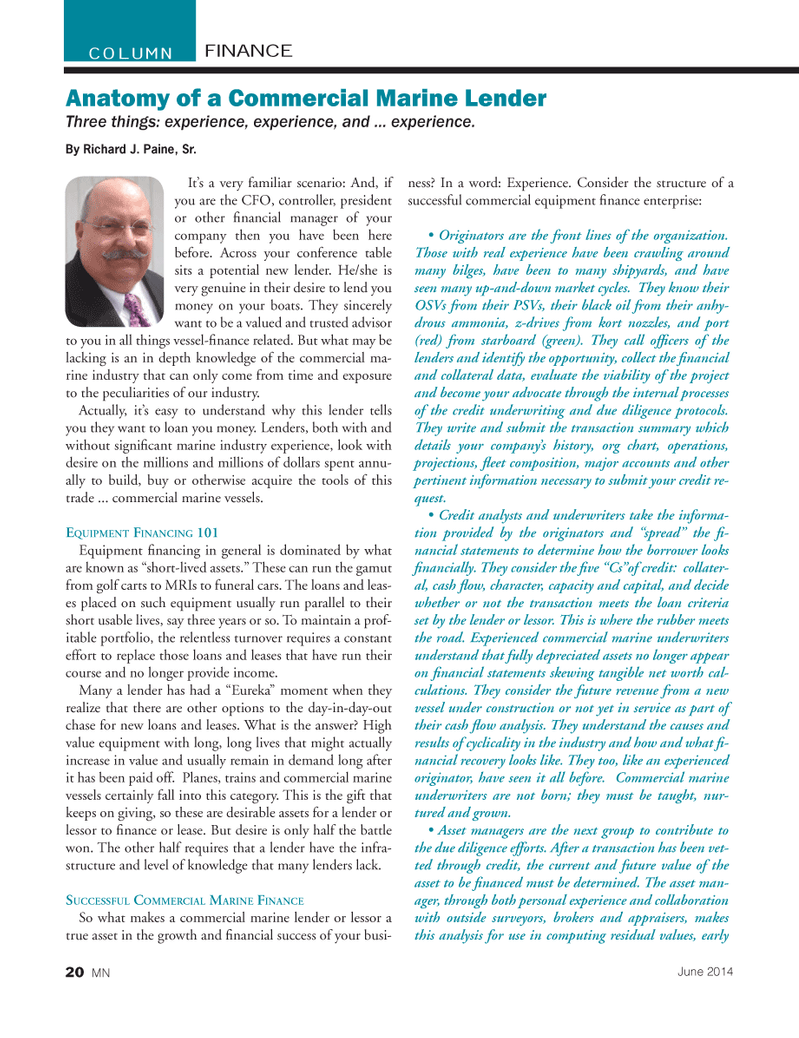
Page 20: of Marine News Magazine (June 2014)
Dredging & Marine Construction
Read this page in Pdf, Flash or Html5 edition of June 2014 Marine News Magazine
It?s a very familiar scenario: And, if you are the CFO, controller, president or other nancial manager of your company then you have been here before. Across your conference table sits a potential new lender. He/she is very genuine in their desire to lend you money on your boats. They sincerely want to be a valued and trusted advisor to you in all things vessel- nance related. But what may be lacking is an in depth knowledge of the commercial ma- rine industry that can only come from time and exposure to the peculiarities of our industry. Actually, it?s easy to understand why this lender tells you they want to loan you money. Lenders, both with and without signi cant marine industry experience, look with desire on the millions and millions of dollars spent annu- ally to build, buy or otherwise acquire the tools of this trade ... commercial marine vessels. EQUIPMENT FINANCING 101Equipment nancing in general is dominated by what are known as ?short-lived assets.? These can run the gamut from golf carts to MRIs to funeral cars. The loans and leas- es placed on such equipment usually run parallel to their short usable lives, say three years or so. To maintain a prof- itable portfolio, the relentless turnover requires a constant effort to replace those loans and leases that have run their course and no longer provide income. Many a lender has had a ?Eureka? moment when they realize that there are other options to the day-in-day-out chase for new loans and leases. What is the answer? High value equipment with long, long lives that might actually increase in value and usually remain in demand long after it has been paid off. Planes, trains and commercial marine vessels certainly fall into this category. This is the gift that keeps on giving, so these are desirable assets for a lender or lessor to nance or lease. But desire is only half the battle won. The other half requires that a lender have the infra- structure and level of knowledge that many lenders lack. SUCCESSFUL COMMERCIAL MARINE FINANCESo what makes a commercial marine lender or lessor a true asset in the growth and nancial success of your busi- ness? In a word: Experience. Consider the structure of a successful commercial equipment nance enterprise: Originators are the front lines of the organization. Those with real experience have been crawling around many bilges, have been to many shipyards, and have seen many up-and-down market cycles. They know their OSVs from their PSVs, their black oil from their anhy- drous ammonia, z-drives from kort nozzles, and port (red) from starboard (green). They call of cers of the lenders and identify the opportunity, collect the nancial and collateral data, evaluate the viability of the project and become your advocate through the internal processes of the credit underwriting and due diligence protocols. They write and submit the transaction summary which details your company?s history, org chart, operations, projections, eet composition, major accounts and other pertinent information necessary to submit your credit re- quest. Credit analysts and underwriters take the informa- tion provided by the originators and ?spread? the -nancial statements to determine how the borrower looks nancially. They consider the ve ?Cs?of credit: collater- al, cash ow, character, capacity and capital, and decide whether or not the transaction meets the loan criteria set by the lender or lessor. This is where the rubber meets the road. Experienced commercial marine underwriters understand that fully depreciated assets no longer appear on nancial statements skewing tangible net worth cal- culations. They consider the future revenue from a new vessel under construction or not yet in service as part of their cash ow analysis. They understand the causes and results of cyclicality in the industry and how and what -nancial recovery looks like. They too, like an experienced originator, have seen it all before. Commercial marine underwriters are not born; they must be taught, nur- tured and grown. Asset managers are the next group to contribute to the due diligence efforts. After a transaction has been vet- ted through credit, the current and future value of the asset to be nanced must be determined. The asset man- ager, through both personal experience and collaboration with outside surveyors, brokers and appraisers, makes this analysis for use in computing residual values, early FINANCECOLUMNAnatomy of a Commercial Marine Lender Three things: experience, experience, and ? experience. By Richard J. Paine, Sr. June 201420 MNMN June14 Layout 18-31.indd 20MN June14 Layout 18-31.indd 205/20/2014 10:28:59 AM5/20/2014 10:28:59 AM

 19
19

 21
21
